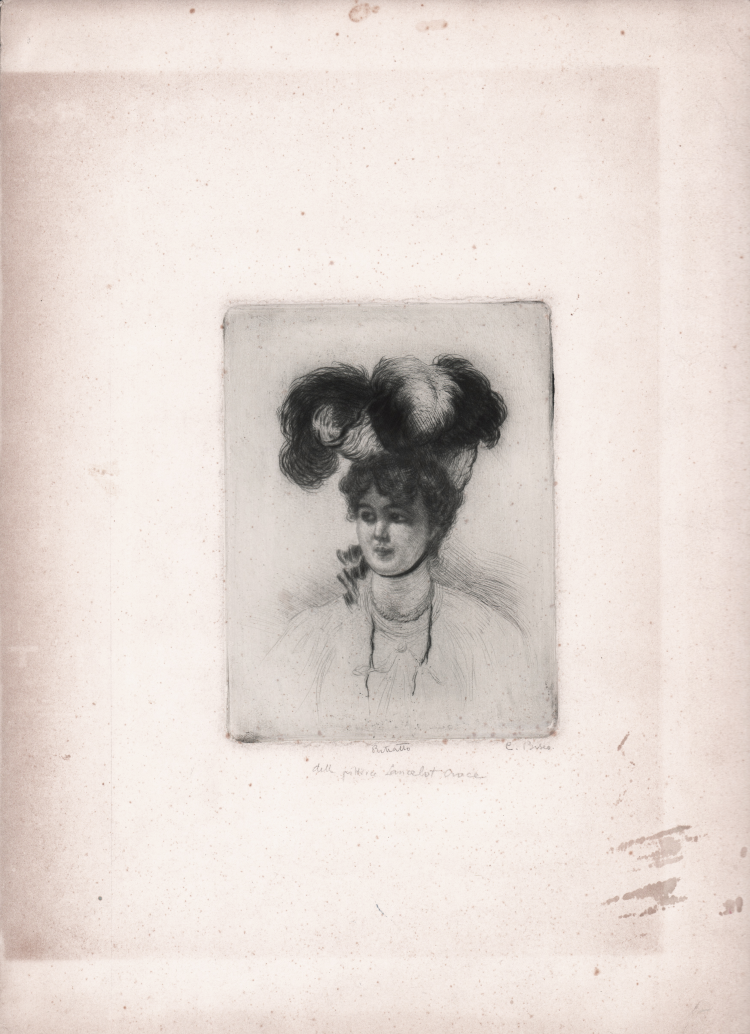



| Reference: | S42103 |
| Author | Cesare BISEO |
| Year: | 1900 ca. |
| Measures: | 130 x 170 mm |


| Reference: | S42103 |
| Author | Cesare BISEO |
| Year: | 1900 ca. |
| Measures: | 130 x 170 mm |
Etching and drypoint, circa 1900. Title in pencil at bottom and autograph signature at bottom right "C. Biseo".
Magnificent example, impressed in green ink on coeval paper, traces of old framing, otherwise in excellent condition.
Marcelle Renée Lancelot (Paris, January 26, 1854 - ca 1946) was a French painter, sculptor and medallist naturalized Italian. Following her marriage to the sculptor Leonardo Croce, she took Italian nationality, changing her name to Marcella. She lived for several years in Rome, starting in 1895. In addition to painting and sculpture, she devoted herself to the profession of medallist since she was young.
The present portrait of Marcella Lancelot Croce, comparing the biographies of the two artists, dates from the period between 1895 and 1909, between the painter's arrival in Rome and Biseo's death.
Work not described by any of the repertories consulted. Very rare.
Cesare Biseo painter, watercolorist and engraver, was born in Rome, where his father, Gian Battista, a talented academic painter from Brescia, had recently moved to decorate the castle of Bracciano. Receives therefore from the father the first artistic teachings and, following the parent, spends as a young man a long period in Paris. In 1869, on the occasion of the inauguration of the Suez Canal, the Kedivé of Egypt called him to decorate first his palace in Alexandria and then the Opera House in Cairo. Having fallen in love with Africa, he visited it several times and in 1875 with Edmondo De Amicis and the painter Stefano Ussi was part of the first Italian mission to Morocco. It draws several albums of sketches, which used to illustrate, along with Ussi, the book of De Amicis, Morocco, published in 1877 by the publisher Treves in Milan. In the same year accompanies De Amicis in Constantinople, then illustrating the homonymous book of the writer published in '78 always by Treves. The great success of both editions consecrates Biseo "orientalist", pushing him to intensify the production of oils and watercolors to Arab subject. Meanwhile in 1875, along with E. Roesler Franz and N. Cipriani, founded in Rome the Society of Watercolorists, of which he became president in 1881. The orientalist vein, in fact, had not made him forget the passion for the landscapes of the Roman countryside, portrayed with great fidelity and original cuts of light ("the bold effect of the sun"), evolving from the original classical taste towards more and more realistic solutions. We also find him among the founding members of the Group of XXV of the Roman Countryside, where Pascarella gives him the nickname of "cariate" for his Egyptian past. He had a studio in Via Margutta and was, as the photos of Oreste Sgambati demonstrate, a frequent visitor to the Caffè Greco, where he was nicknamed "professorissimo" for his mastery at billiards. In addition to the frescoes and decorations of the early days, he painted equally well in oil and watercolor. He also devoted himself successfully to etching, as evidenced by his beautiful book illustrations.
Cesare BISEO (Roma 1843 - 1909)
|
He was a pupil of his father Giovanni Battista. On invitation of the viceroy of Egypt he went to Alexandria, where he frescoed the Palace of the Government. It was orientalist painter of great emotional depth and great chromatic richness. In 1875, with Edmondo De Amicis and Stefano Ussi, he went to Morocco, as a member of an Italian diplomatic mission. He then performed the illustrations for the books of Edmondo De Amicis Marocco, published in 1879 (in collaboration with Stefano Ussi) and Constantinopoli, published in 1882. He also studied the techniques of etching and engraved, referring to Piranesi, views with Roman ruins. Among his works remember Nel deserto, exhibited in Rome, at the National Gallery of Modern Art.
|
Cesare BISEO (Roma 1843 - 1909)
|
He was a pupil of his father Giovanni Battista. On invitation of the viceroy of Egypt he went to Alexandria, where he frescoed the Palace of the Government. It was orientalist painter of great emotional depth and great chromatic richness. In 1875, with Edmondo De Amicis and Stefano Ussi, he went to Morocco, as a member of an Italian diplomatic mission. He then performed the illustrations for the books of Edmondo De Amicis Marocco, published in 1879 (in collaboration with Stefano Ussi) and Constantinopoli, published in 1882. He also studied the techniques of etching and engraved, referring to Piranesi, views with Roman ruins. Among his works remember Nel deserto, exhibited in Rome, at the National Gallery of Modern Art.
|